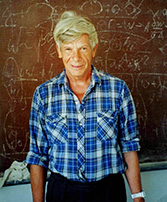Speaker
Description
We examine the Chandrasekhar limit for white dwarfs in $f(R)$
gravity, with a simple polytropic equation of state describing
stellar matter. We use the most popular $f(R)$ gravity model,
namely the $f(R)=R+\alpha R^2$ gravity, and calculate the
parameters of the stellar configurations with polytropic equation
of state of the form $p=K\rho^{1+1/n}$ for various values of the
parameter $n$. In order to simplify our analysis we use the
equivalent Einstein frame form of $R^2$-gravity which is basically
a scalar-tensor theory with well-known potential for the scalar
field. In this description one can use simple approximations for
the scalar field $\phi$ leaving only the potential term for it.
Our analysis indicates that for the non-relativistic case with
$n=3/2$, discrepancies between the $R^2$-gravity and General
Relativity can appear only when the parameter $\alpha$ of the
$R^2$ term, takes values close to maximal limit derived from the
binary pulsar data namely $\alpha_{max}=5\times 10^{15}$ cm$^2$.
Thus, the study of low-mass white dwarfs can hardly give
restrictions on the parameter $\alpha$. For relativistic
polytropes with $n=3$ we found that Chandrasekhar limit can in
principle change for smaller $\alpha$ values. The main conclusion
from our calculations is the existence of white dwarfs with large
masses $\sim 1.33 M_{\odot}$, which can impose more strict limits
on the parameter $\alpha$ for the $R^2$ gravity model.
Specifically, our estimations on the parameter $\alpha$ of the
$R^2$ model is $\alpha \sim 10^{13}$ cm$^2$.

